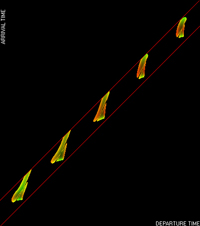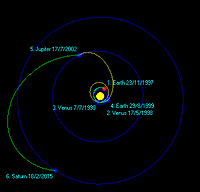Advances in Global Optimisation for Interplanetary Trajectory Design

The main goal of this activity is to improve the numerical efficiency of the trajectory design process by resorting to the latest advances in global optimisation theory and astrodynamics.
Project overview
The problem of trajectory optimisation is a complex problem. Take the most simple case of a direct transfer to Mars and consider possible launches in the decade 2015-2025 having a relative speed at departure and at arrival smaller than 8000m/s. In the Figure below a graphical representation of the required propellant mass to perform such a mission is given.

We recognize the famous Pork-Chop plots repeating at every synodical period. Because of the numerous locally optimal trajectories (in the Figure above the color shading has been made proportional to the propellant mass used) the use of a gradient method would not be efficient to find the best possible trajectory already in this simple case. If we then consider also the possibility of powered gravity assists, low-thrust arcs and deep space manouvres the search space becomes so complicated that there is no hope of finding the globally optimal trajectory using randomly initiated gradient descent.
A solution is that of using global optimisation techniques to search efficiently the space of feasible solutions. Here the problem is the incredibly large number of global optimisers available and their vastly varying performances according to the problem tackled. A first attempt to classify a number of these techniques according to their performances in space mission design related problems has been done by the Advanced Concepts Team in cooperation with the Universities of Reading and Glasgow. The results are available via the ACT publication page and are contained in the final reports of the ARIADNA studies entitled "Advanced Global Optimisation Tools for Mission nalysis and Design" and on the paper presented at the GO05 conference in Almeria and later published in Journal of Global Optimisation.
One of the most important result was the reccomendation to use Differential Evolution as a global optimisation algorithm for space trajectory design. An example of the performance achievable by this algorithm combined with a space pruning technique introduced ad hoc for the multiple gravity assist problem is here reported. The Global Optimum of an Earth-Venus-Venus-Earth-Jupiter-Saturn transfer with powered swing-bys is shown in the Figure above. The launch window considered in MJD2000 is tE=[-1462 338], tV1=[-1448 622], tV2=[-1426 1064], tE2=[-1412 1328], tJ=[-1313 3287], tS=[-907 10653] and the global optimum was located in roughly 4 seconds on a Pentium IV 2.8GHz personal computer. The minimal DV found was in this case 4944 m/s (ephemerides used were analytical).

The results also showed how the simple Multipe Gravity Assist problem has a polynomial complexity both in time and in space whenever the proposed pruning technique is used. When the problem is more complicated than the simple Multiple Gravity Assist the "curse of dimentionality" could literally stop the trajectory design process. In these cases one may on one hand reduce the search space by exploiting some particular techniques (e.g. exponential sinusoids) or try to increase the computing power available by distributing the optimiser on a very large net of computers. This last possibility is currently being investigated using the ACT distributed computing environment to design a Multiobjective Global Optimiser. The resulting software that has been called DiGMO is currently under development and is able to self-learn the best optimisation strategy to tackle a given problem.
Links & references
- GTOC: the Global Trajectory Optimisation Competition
- Global Optimisation pages in informatics
- Lambert problem solution for the exponential sinusoids